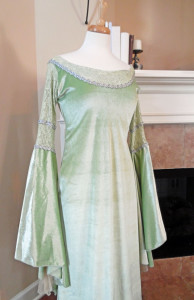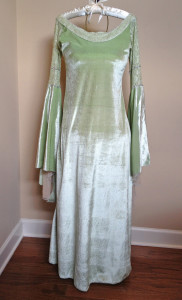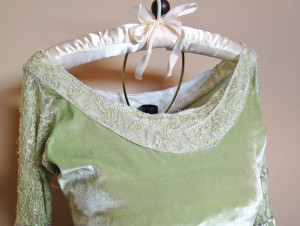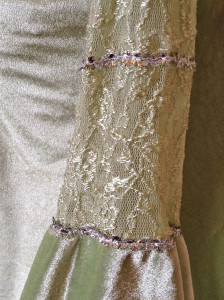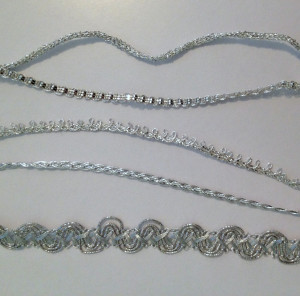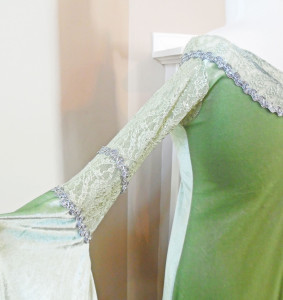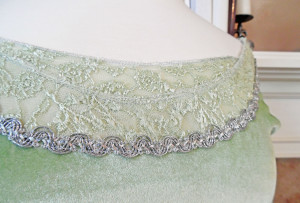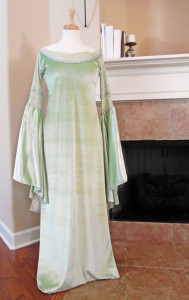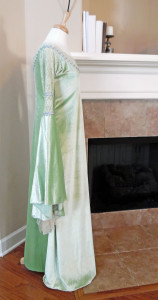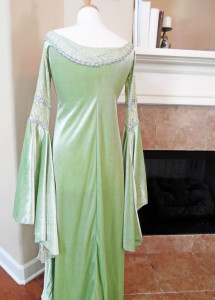A Sewing Diary
by Lisha Vidler
Last summer, on a trip to California, I made an amazing thrift store find. Amidst discarded bridesmaids’ dresses and tattered Halloween costumes, I discovered a pale green medieval gown. At once, I recognized it as a replica of Arwen’s coronation gown, as seen in the final Lord of the Rings movie, The Return of the King. It cost me $4.95.
The gown wasn’t in the best condition, so I decided to give it a bit of a makeover.
(Click any photo to see the full-sized image.)
Description
Most of the dress is a pale leaf-green stretch velvet. The neckline and upper part of the sleeves are a floral stretch lace, dyed to match. The lower sleeves are belled in a common medieval-fantasy style, and they’re lined with sheer, flesh-colored tricot undersleeves.
Problems
As I mentioned, the gown wasn’t the highest quality. Here’s a few of the problems I found:
- Some of the seams hadn’t been serged straight, which created gaps in the stitching.
- There were loose threads everywhere.
- Some of the lace was snagged and/or frayed.
- The silver rickrack on the sleeves was falling off.
- The rickrack was also terribly frayed.
- There was no hem.
My goal was to repair the seams, hem the skirt, replace the silver rickrack, and add matching silver trim around the neckline. I also wanted to bead the upper sleeves and neckline, to give the dress some sparkle.
Makeover
To start, I snipped all the loose threads and bits of shredded lace. Using matching thread, I hand-stitched all the loose flaps and holes where the seams hadn’t caught. This took perhaps half an hour.
Next, I looked at the silver rickrack. It was frayed in places, and had come unstitched in others, so I went ahead and removed it.
I had several different silver trims in my stash, but since I primarily work with doll clothes, I didn’t have a lot of yardage of any of these trims. I measured the one I liked best and found that I would have just enough to edge the sleeves and neckline. In the photo below, it’s the bottom trim.
I sewed the first row of braid on top of the seam that connects the upper and lower sleeve. I placed the second row about three and a half inches above that. Because the fabric is stretchy, I attached the trim with a catch-stitch. This allows some give, so the thread won’t break when the fabric is stretched.
The real coronation gown has silver trim and beaded embroidery along the neckline, so I decided to fancy mine up a little by adding a row of the silver braid along the lower edge of the lace neckline. Again, I used a catch-stitch, so the trim could stretch with the gown.
The bottom edge of the skirt had been serged, but not actually hemmed, so I turned it under and sewed the hem by hand.
My final goal was to bead the neckline and sleeves. I couldn’t, however, because they’re made of stretch lace. If I’d used regular thread, it would have snapped the first time someone pulled the gown on over their head. And I couldn’t find an elastic thread fine enough to fit through seed beads. A disappointment, to be sure, but I’m still quite pleased with how the dress turned out.

